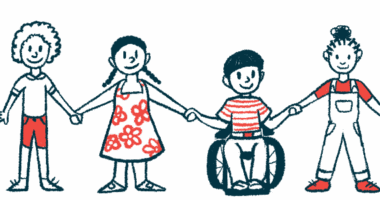Spinal Muscular Atrophy: June Bi-Monthly Roundup

Since our last roundup, there has been continued focus in the spinal muscular atrophy (SMA) literature how best to treat the disease. There also continues to be research geared toward understanding the biology of the disease, as well as on SMA management, what it is like to live with the disease, and the costs of the disease to the healthcare system.
See below for a roundup of the latest SMA literature.
Understanding SMA
Comprehensive Modeling of Spinal Muscular Atrophy in Drosophila melanogaster.1
Data from this recently published study show that the fly is an adequate model for recapitulating the locomotor decline that is observed in SMA when the genetics of SMA are closely mimicked in these models.
Read more here.
Adult-onset SMALED2 due to a novel BICD2 mutation presenting with asymmetrical lower limb involvement.2
This case report describes the clinical features of family members with SMA with lower extremity predominance (SMALED2) and demonstrates that SMALED2 patients can present with late adult-onset muscle weakness and lower extremity wasting.
Read more here.
VAMP associated proteins are required for autophagic and lysosomal degradation by promoting a Ptdlns4P-mediated endosomal pathway.3
This study examines the damage caused by a mutation to an endoplasmic reticulum (ER) protein that is observed in SMA and amyotrophic lateral sclerosis (ALS) and suggests that lower levels of the protein are associated with a failure of the ER and Golgi to tether. The results appear to involve an increase in Golgi phosphatidylinositol-4-phosphate levels and a reduction in functioning lysomes.
Read more here.
Treating SMA
Is there hope for spinal muscular atrophy synthetic pharmacotherapy?4
Advances in pharmacotherapy used for SMA are covered in this editorial. The author also puts forth evidence for why there is more hope than ever before that an effective treatment for SMA will be developed.
Read more here.
Nusinersen in later-onset spinal muscular atrophy: Long-term results from the phase ½ studies.5
In this new article published in Neurology, the authors report the results of nusinersen administered intrathecally to children with later-onset SMA, including SMA type 3. The data show that motor function improved and disease activity stabilized over a 3 year period in study participants.
Read more here.
Nusinersen for SMA: Not just for babies?6
This editorial discusses data from clinical trials investigating the effects of nusinersen on children and adolescents with SMA. The authors posit that nusinersen will likely begin to be used to regularly treat pe-symptomatic SMA patients. They also highlight the ongoing question of if nusinersen should be used in older patients with SMA type 3.
Read more here.
Scoliosis and spinal muscular atrophy in the new world of medical therapy: providing lumbar access for intrathecal treatment in patients previously treated or undergoing spinal instrumentation and fusion.7
Nusinersen, the recently approved treatment for SMA, is traditionally administered through intrathecal injections. In patients with scoliosis, this route of administration can be particularly challenging. This study provides evidence for an easier and safer method for providing intrathecal access in these patients.
Read more here.
NMR solution structure of tricyclo-DNA containing duplexes: insight into enhanced thermal stability and nuclease resistance.8
This new study helps to clarify the structure and geometry of the tricyclo-DNA family (tc-DNA). Because it has recently been discovered that tc-DNA antisense oligonucleotides (ASOs) are promising candidates in the treatment of SMA, this high-resolution structural information provides important insights for drug development.
Read more here.
Neurofilament as a potential biomarker for spinal muscular atrophy.9
This article provides information on an investigation into plasma phosophorylated neurofilament heavy chain (pNF-H) as a potential biomarker for SMA. Researchers found that plasma levels of pNF-H were higher than normal in infants with SMA. They also found that nusinersen therapy is associated with a lowering of pNF-H levels. Based on these results, the researchers conclude that plasma pNF-H is a promising candidate as a marker of SMA disease that can be used to evaluate infants’ responses to SMA treatments.
Read more here.
Recent Reviews:
- Antisense therapies for neurological disease.10
This new review discusses the antisense olignonucleotide (ASO) drugs that are currently being used to treat SMA and other neurological diseases, as well as current pre-clinical research aimed at developing new ASO therapies.
Read the review here.
- Characteristics and advantages of adeno-associated virus vector-mediated gene therapy for neurodegenerative diseases.11
Many recent clinical trials have focused on adeno-associated virus as a vector for neurodegenerative disease therapies. This review describes how this virus appears to be a safe vector that can mediate gene transfer to the nervous system efficiently and summarizes clinically relevant progress that has been made in our understanding of the adeno-associated virus for SMA and other neurodegenerative diseases.
Read the review here.
Managing SMA
Natural course of scoliosis and lifetime risk of scoliosis surgery in spinal muscular atrophy.12
This study investigated the likelihood of scoliosis surgery among those with SMA. The results showed that those with SMA type 1c and SMA type 2 were more likely to undergo scoliosis surgery. For those with SMA type 3, the likelihood of this type of surgery appeared to depend on the age at which patients stop walking. The authors suggest that the findings may improve evaluation of the long-terms effects of SMA therapies by allowing researchers to consider specific motor milestones.
Read more here.
Resolution of skin necrosis after nusinersen treatment in an infant with spinal muscular atrophy.13
This case report describes the skin lesions on a 9-month old girl who was diagnosed with SMA type 1 at birth. The patient, who has 1 copy of SMN2, experienced resolution of her skin lesions at the age of 7 months after receiving intrathecal nusinersen injections.
Read more here.
Radiation exposure of image-guided intrathecal administration of nusinersen to adult patients with spinal muscular atrophy.14
This article describes the results of a study that was undertaken to determine if SMA patients receiving image-guided intrathecal nusinersen treatments are exposed to higher levels of radiation because of their anatomical susceptibility. The results showed that compared to patients without SMA receiving image-guided injections, SMA patients were not exposed to more radiation.
Read more here.
Inhospital complications of patients with neuromuscular disorders undergoing total joint arthroplasty.15
In this article, the authors describe a retrospective cohort study examining the prevalence of total joint arthroplasty in patients with neuromuscular diseases including SMA type 3. Features of the hospital experience are also discussed.
Read more here.
Patient Focus and Policy Implications
Perceived fatigue in spinal muscular atrophy: A pilot study.17
In this article, the authors report the details of their study on perceived fatigue in patients with SMA. Each of the SMA patients studied reported fatigue, but the patients’ perceived fatigue did not correlate with objective performance measures and was not influenced by factors such as age or ambulatory status.
Read more here.
High healthcare resource use in hospitalized patients with a diagnosis of spinal muscular atrophy type 1 (SMA): Retrospective analysis of the kids’ inpatient database (KID).18
This piece provides information on a study examining costs associated with SMA type 1. The authors found that the average cost for hospital admissions for infants with SMA type 1 are higher than that of those without complex chronic conditions. Because SMA type 1 patients tend to require frequent hospitalizations, the authors suggest that the costs may have a significant societal impact.
Read more here.
References
1. Spring AM, Raimer AC, Hamilton CD, Schillinger MJ, Matera AG. Comprehensive Modeling of Spinal Muscular Atrophy in Drosophila melanogaster. Front Mol Neurosci. 2019;12:113. doi:10.3389/fnmol.2019.00113
2. Wan C, Wang Y, Zhou Q, Yu Y, Hong D, Zhu M. Adult-onset SMALED2 due to a novel BICD2 mutation presenting with asymmetrical lower limb involvement. Clin Neuropathol. 2019;38(3):109-117. doi:10.5414/NP301144
3. Mao D, Lin G, Tepe B, et al. VAMP associated proteins are required for autophagic and lysosomal degradation by promoting a PtdIns4P-mediated endosomal pathway. Autophagy. 2019;15(7):1214-1233. doi:10.1080/15548627.2019.1580103
4. Riessland M. Is there hope for spinal muscular atrophy synthetic pharmacotherapy? Expert Opin Pharmacother. 2019;20(9):1049-1052. doi:10.1080/14656566.2019.1595585
5. Darras BT, Chiriboga CA, Iannaccone ST, et al. Nusinersen in later-onset spinal muscular atrophy: Long-term results from the phase 1/2 studies. Neurology. 2019;92(21):e2492-e2506. doi:10.1212/WNL.0000000000007527
6. Ciafaloni E, Russman BS. Nusinersen for spinal muscular atrophy: Not just for babies? Neurology. 2019;92(21):985-986. doi:10.1212/WNL.0000000000007559
7. Labianca L, Weinstein SL. Scoliosis and spinal muscular atrophy in the new world of medical therapy: providing lumbar access for intrathecal treatment in patients previously treated or undergoing spinal instrumentation and fusion. J Pediatr Orthop B. 2019;28(4):393-396. doi:10.1097/BPB.0000000000000632
8. Istrate A, Johannsen S, Istrate A, Sigel RKO, Leumann CJ. NMR solution structure of tricyclo-DNA containing duplexes: insight into enhanced thermal stability and nuclease resistance. Nucleic Acids Res. 2019;47(9):4872-4882. doi:10.1093/nar/gkz197
9. Darras BT, Crawford TO, Finkel RS, et al. Neurofilament as a potential biomarker for spinal muscular atrophy. Ann Clin Transl Neurol. 2019;6(5):932-944. doi:10.1002/acn3.779
10. Pulst S-M. [Antisense therapies for neurological diseases]. Nervenarzt. June 2019. doi:10.1007/s00115-019-0724-4
11. Qu Y, Liu Y, Noor AF, Tran J, Li R. Characteristics and advantages of adeno-associated virus vector-mediated gene therapy for neurodegenerative diseases. Neural Regen Res. 2019;14(6):931-938. doi:10.4103/1673-5374.250570
12. Wijngaarde CA, Brink RC, de Kort FAS, et al. Natural course of scoliosis and lifetime risk of scoliosis surgery in spinal muscular atrophy. Neurology. June 2019. doi:10.1212/WNL.0000000000007742
13. Salmin F, Albamonte E, Morettini V, Gagliano N, Mercuri E, Sansone VA. Resolution of skin necrosis after nusinersen treatment in an infant with spinal muscular atrophy. Muscle Nerve. 2019;59(6):E42-E44. doi:10.1002/mus.26457
14. Oldenburg D, Guberina N, Stolte B, et al. Radiation exposure of image-guided intrathecal administration of nusinersen to adult patients with spinal muscular atrophy. Neuroradiology. 2019;61(5):565-574. doi:10.1007/s00234-019-02189-x
15. Cichos KH, Lehtonen EJ, McGwin GJ, Ponce BA, Ghanem ES. Inhospital Complications of Patients With Neuromuscular Disorders Undergoing Total Joint Arthroplasty. J Am Acad Orthop Surg. 2019;27(11):e535-e543. doi:10.5435/JAAOS-D-18-00312
16. Mastrangelo M. Clinical approach to neurodegenerative disorders in childhood: an updated overview. Acta Neurol Belg. June 2019. doi:10.1007/s13760-019-01160-0
17. Dunaway Young S, Montes J, Kramer SS, Podwika B, Rao AK, De Vivo DC. Perceived Fatigue in Spinal Muscular Atrophy: A Pilot Study. J Neuromuscul Dis. 2019;6(1):109-117. doi:10.3233/JND-180342
18. Cardenas J, Menier M, Heitzer MD, Sproule DM. High Healthcare Resource Use in Hospitalized Patients with a Diagnosis of Spinal Muscular Atrophy Type 1 (SMA1): Retrospective Analysis of the Kids’ Inpatient Database (KID). PharmacoEconomics – open. 2019;3(2):205-213. doi:10.1007/s41669-018-0093-0



